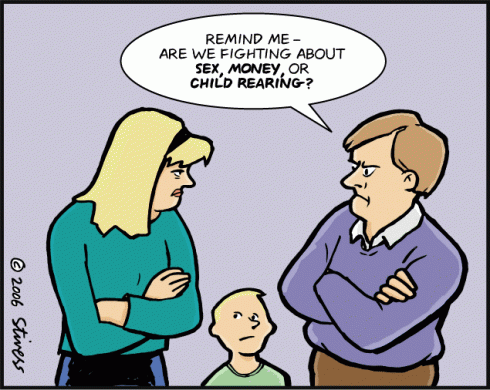Valentine’s Day is over, leftovers are eaten, and your flowers are probably about ready to be tossed out. So now that the niceties have been dispensed with and you’re not in the clutches of any Hallmark Magic, how’s your relationship faring? If it’s not going well, it can be taking a toll on your sleep and overall health – which can be affecting your beauty! If you’re not sleeping well, overeating from stress, and not taking care of yourself, it’s hard to look your best. So, while it’s not straightforward beauty advice, I wanted to share this article about how to improve your relationship! If you’re not interested, feel free to skip to the next article – otherwise, follow the jump!
Seven Guidelines for Middle-Ground Communication
By Marty Babits, LCSW, BCD,
Author of The Power of Middle Ground: A Couple’s Guide to Renewing Your Relationship
If you need help regulating and resolving conflict, these guidelines are for you. They can help you make difficult conversations productive, steer you and your partner away from destructive talk, and help you nurture an atmosphere of emotional safety. Adopting these guidelines, whenever pertinent, will safeguard the middle ground within your relationship:
1.
Avoid generalizing and stereotyping. Do not generalize about your partner’s moods. When you think you know how your partner feels, but don’t stop to ask or listen, they’ll often feel neglected and misunderstood. Rule of thumb: there is often a difference between how your partner feels and how you think they feel. Your partner’s sense of emotional safety, as a result of generalizing, can become depleted.
2.
Do not blurt responses. Do you identify with the following statement: “I didn’t even know what I was going to say until I heard myself saying it.” If so, this is an especially important guideline for you. Monitor your thoughts while speaking with your partner. There is always more than one way to say something, choose according to the effect you want your remark to have. Do not blurt the first thing that comes to mind at your partner.
3.
No name calling. If you are disgusted with something that is going on and call your mate something mean, the communication flow stops. And turning it back on becomes more and more difficult, in proportion to the amount of name-calling that goes on. When thinking before speaking, edit out the put-downs. Basic as the guidelines may seem, under stress, sticking to them is a challenge for us all.
4.
Speak honestly and judiciously. The abiding ways that you feel — positive and negative — need to be represented in your dialogue with your partner. Keeping dominant thoughts and feelings buried will not further the relationship. But pay close attention to how you share information. Notice for signs that your partner is getting flooded. Do not keep talking if they are feeling overwhelmed! Conveying your messages with finesse and forethought will payoff big time in trust and emotional safety dividends.
5.
Develop patience. Sustain it. Patience within a specific talk and in the pacing of your dialogue overall can make a critical difference to relationship healing. Patience and humility blended together compose emotional stamina, which is fundamental to the creation of a secure long-term love relationship. Healing your relationship without patience? It’s impossible. So work on this one!
6.
Think about what your partner says in terms of who your partner is. You need to develop a “relationship” perspective that features a good grasp of how the situation is understood by your partner as well as by yourself. Remember — understanding how your partner feels from within his or her purview does not mean you are acknowledging that their perspective is correct. You are not surrendering your point of view. You are simply acknowledging that yours is not the only legitimate point of view.
7.
Time-out signal — have it in place; use it as needed. Using time-outs can allow you a sense of control in the pacing of your dialogue. In the case of complex and/or difficult emotional issues this can make the difference between whether you can or can’t discuss an issue productively. Without a pre-arranged signal to allow a safe method for temporarily suspending the dialogue, restarting it will be more difficult. Using time-outs does not mean that difficult issues go unaddressed. It does mean that partners have to work as a team to keep the flow of conversation going — not simply within a single talk but between talks as well. Carve a niche in your relationship that honors this dimension of awareness and sensitivity.
Can these seven guidelines help save a floundering relationship? The short answer is yes. Yes, they can. If you follow them consistently, you will see results. Putting these into practice with your partner will help you both learn to understand each other better, and come to find your middle ground.
© 2010 Marty Babits, LCSW, BCD, author of The Power of the Middle Ground: A Couple’s Guide to Renewing Your Relationship
Author Bio
Marty Babits, LCSW, BCD (New York, NY), author of The Power of the Middle Ground: A Couple’s Guide to Renewing Your Relationship, is a psychotherapist in private practice and a member of the Executive Supervisory Committee of FACTS (the Family and Couples Treatment Service) of the Institute for Contemporary Psychotherapy.
For more information, please visit www.PowerOfTheMiddleGround.com.
